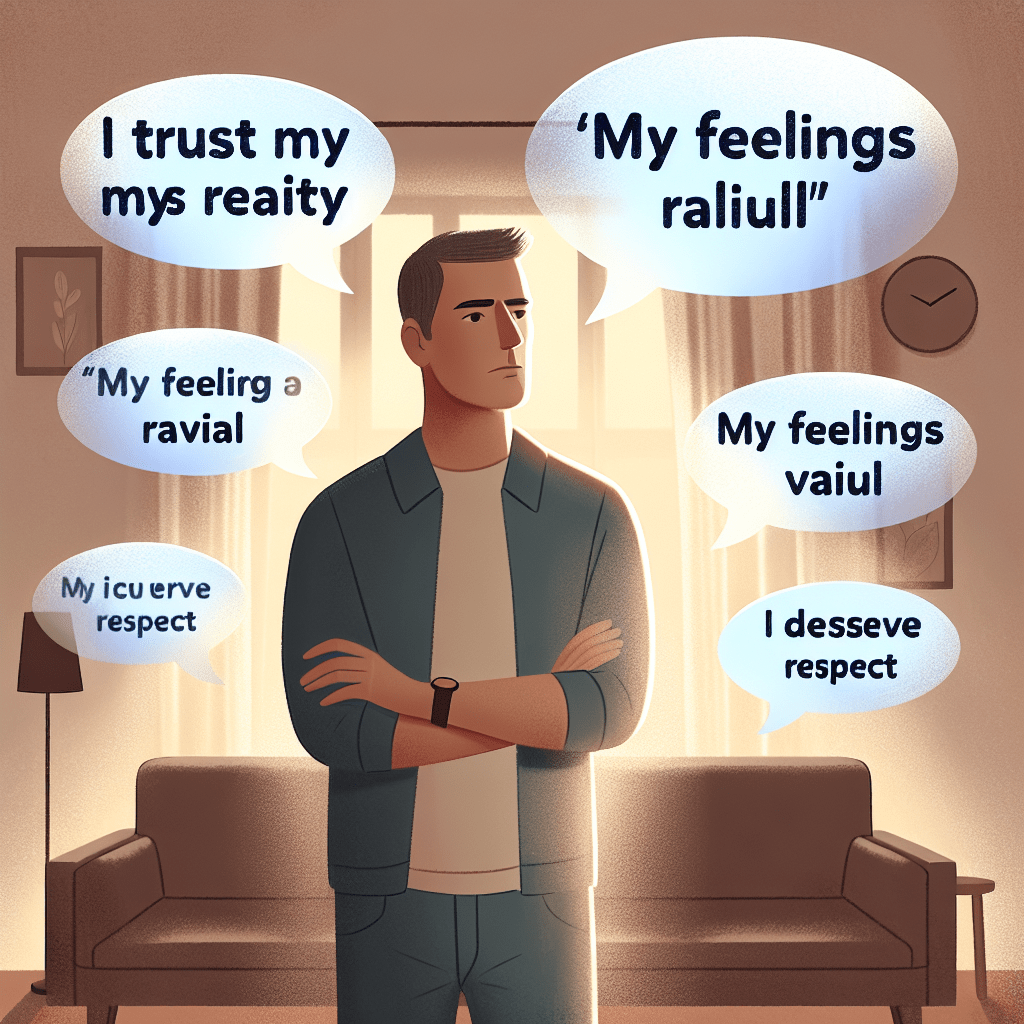-
Table of Contents
What is the Best Response to Gaslighting?
Gaslighting is a form of psychological manipulation in which an individual or group seeks to sow seeds of doubt in a targeted person, making them question their own memory, perception, or sanity. It can be a challenging situation to navigate, but the best response to gaslighting involves recognizing the manipulation, setting boundaries, seeking support, and prioritizing self-care.
Recognizing Gaslighting: Signs and Red Flags
What is the Best Response to Gaslighting?
Gaslighting is a form of psychological manipulation that can leave its victims feeling confused, doubting their own reality, and questioning their sanity. It is a tactic often used by individuals who seek to gain power and control over others. Gaslighting can occur in various relationships, such as romantic partnerships, friendships, or even in professional settings. Recognizing the signs and red flags of gaslighting is crucial in order to protect oneself and respond effectively.
One of the most common signs of gaslighting is the constant denial or dismissal of the victim’s experiences and feelings. The gaslighter may repeatedly tell the victim that their perceptions are wrong or that they are overreacting. This can lead the victim to doubt their own judgment and question their own reality. Another red flag is the gaslighter’s tendency to twist the truth or manipulate facts to suit their own narrative. They may distort events or conversations, making the victim question their memory and perception of what actually happened.
Gaslighters often engage in tactics aimed at undermining the victim’s self-esteem and confidence. They may belittle the victim, criticize their abilities, or make them feel inadequate. By doing so, the gaslighter gains a sense of power and control over the victim. Additionally, gaslighters may isolate their victims from friends and family, making them more dependent on the gaslighter for validation and support. This isolation further strengthens the gaslighter’s control over the victim.
Recognizing these signs and red flags is the first step in responding effectively to gaslighting. It is important to trust your instincts and not dismiss your own feelings and experiences. Gaslighting thrives on the victim’s self-doubt, so it is crucial to maintain a strong sense of self and confidence in your own perceptions.
When faced with gaslighting, it is important to set boundaries and assert your own reality. Communicate your feelings and experiences clearly and assertively, without allowing the gaslighter to dismiss or invalidate them. It can be helpful to keep a journal or record of incidents to refer back to when doubts arise. This can serve as a reminder of the gaslighter’s tactics and help you maintain clarity.
Seeking support from trusted friends, family, or professionals can also be beneficial. Gaslighting can be incredibly isolating, so having a support system in place can provide validation and perspective. Therapists or counselors can offer guidance and help you develop strategies to cope with gaslighting.
It is important to remember that you are not responsible for the gaslighter’s behavior. Gaslighting is a form of manipulation, and the responsibility lies solely with the gaslighter. It is not your fault, and you deserve to be treated with respect and dignity.
Recognizing the signs and red flags of gaslighting is crucial in order to respond effectively. Trusting your instincts, setting boundaries, seeking support, and maintaining a strong sense of self are key in navigating gaslighting situations. Remember, you are not alone, and there are resources available to help you through this challenging experience.
Effective Strategies for Responding to Gaslighting

One of the most important strategies when dealing with gaslighting is to trust your own instincts and perceptions. Gaslighters often try to make their victims doubt themselves by constantly questioning their thoughts, feelings, and memories. They may say things like, “You’re overreacting” or “That never happened.” In these situations, it is crucial to remind yourself that your feelings and experiences are valid. Trusting your own judgment can help you resist the gaslighter’s attempts to manipulate and control you.
Another effective response to gaslighting is to set boundaries and assert your needs. Gaslighters often try to undermine their victims’ sense of self-worth and autonomy. They may belittle your opinions, dismiss your emotions, or invade your personal space. By setting clear boundaries and expressing your needs, you can assert your independence and protect yourself from further manipulation. For example, you can say, “I will not tolerate being spoken to in that way” or “I need some time alone to process my thoughts and feelings.”
It is also important to seek support from trusted friends, family members, or professionals. Gaslighters thrive on isolating their victims and making them feel like they have no one to turn to. By reaching out to others, you can gain perspective, validation, and emotional support. Talking to someone who understands the dynamics of gaslighting can help you regain your confidence and strengthen your resolve to confront the gaslighter.
When responding to gaslighting, it is crucial to maintain your composure and avoid engaging in arguments or power struggles. Gaslighters often thrive on conflict and may escalate the situation to further manipulate and control you. Instead, try to remain calm and composed. Take deep breaths, count to ten, or remove yourself from the situation if necessary. By refusing to engage in their manipulative tactics, you can maintain your own sense of control and prevent the gaslighter from further undermining your reality.
Self-care is another essential aspect of responding to gaslighting. Gaslighters often try to make their victims feel unworthy, inadequate, or crazy. Engaging in activities that bring you joy, practicing self-compassion, and prioritizing your well-being can help counteract the negative effects of gaslighting. Taking care of yourself physically, emotionally, and mentally can strengthen your resilience and empower you to confront the gaslighter with confidence.
In conclusion, gaslighting is a harmful form of psychological manipulation that can leave victims feeling confused and isolated. However, there are effective strategies for responding to gaslighting and regaining control of one’s own reality. Trusting your instincts, setting boundaries, seeking support, maintaining composure, and practicing self-care are all crucial steps in confronting gaslighters and protecting yourself from further manipulation. Remember, you are not alone, and your experiences and feelings are valid.
Seeking Support: How to Deal with Gaslighting in Relationships
What is the Best Response to Gaslighting?
One of the most crucial steps in dealing with gaslighting is seeking support. Gaslighters often isolate their victims, making them feel alone and helpless. Therefore, reaching out to trusted friends, family members, or professionals can provide a much-needed support system. Sharing experiences with others who have gone through similar situations can be validating and empowering.
Therapy can be an invaluable resource for individuals dealing with gaslighting. A therapist can help victims regain their self-esteem, rebuild their confidence, and develop coping strategies. They can also provide a safe space for victims to express their emotions and process their experiences. Therapy can be particularly beneficial for those who have been gaslighted for an extended period, as it can help them reestablish a sense of reality and trust in their own perceptions.
Educating oneself about gaslighting is another essential step in dealing with this form of manipulation. Understanding the tactics used by gaslighters can help victims recognize when they are being manipulated. It can also provide them with the knowledge and tools to respond effectively. There are numerous books, articles, and online resources available that delve into the topic of gaslighting and provide guidance on how to navigate such situations.
Setting boundaries is crucial when dealing with gaslighting. Gaslighters often push boundaries and violate personal space, making it essential for victims to establish clear limits. This can involve asserting oneself and expressing discomfort when faced with manipulative behavior. It may also require creating physical or emotional distance from the gaslighter to protect one’s mental well-being.
Self-care is paramount when dealing with gaslighting. Victims often experience a range of emotions, including self-doubt, anxiety, and depression. Engaging in activities that promote self-care, such as exercise, meditation, or hobbies, can help individuals regain a sense of control and well-being. Taking care of one’s physical and mental health is crucial in rebuilding self-esteem and resilience.
It is important to remember that leaving a gaslighting relationship is a valid option. In some cases, the best response to gaslighting may be to remove oneself from the toxic environment altogether. This decision should be made with careful consideration and support from trusted individuals. Leaving a gaslighting relationship can be challenging, but it can also be liberating and allow victims to reclaim their lives.
Conclusion
What is the Best Response to Gaslighting?
The best response to gaslighting is to recognize and validate your own feelings and experiences, seek support from trusted individuals, set boundaries, and consider seeking professional help if needed.
